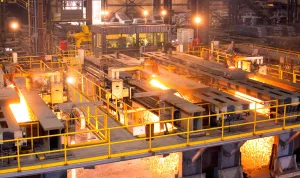Understanding How Currency Fluctuations Impact ArcelorMittal (MT) Stock Performance

ArcelorMittal (MT), the world’s largest steel producer, operates in a complex global environment, with production facilities, supply chains, and customers spread across multiple countries. This extensive international presence exposes the company to currency fluctuations, which can have a significant impact on its financial performance and, consequently, its stock price. In this article, we’ll explore how currency fluctuations affect ArcelorMittal’s stock, the risks involved, and what investors need to know to navigate these dynamics effectively.
1. The Basics of Currency Fluctuations and Their Impact
Currency fluctuations refer to the changes in the value of one currency relative to another. These fluctuations are driven by various factors, including economic conditions, interest rates, political stability, and market speculation. For a global company like ArcelorMittal, these changes can affect both the revenue generated from international operations and the costs incurred in different currencies.
Revenue Impact: ArcelorMittal earns a significant portion of its revenue in foreign currencies, such as the euro, Indian rupee, and Brazilian real, while reporting its financial results in U.S. dollars. When the U.S. dollar strengthens against these currencies, the company’s foreign revenue is worth less in dollar terms, potentially reducing overall revenue and profitability. Conversely, a weaker dollar can enhance the value of foreign earnings, boosting revenue.
Cost Impact: Currency fluctuations also affect ArcelorMittal’s costs. The company purchases raw materials, such as iron ore and coal, from global suppliers, and fluctuations in the currencies of supplier countries can impact production costs. Additionally, changes in exchange rates can affect the cost of financing, especially if the company holds debt in multiple currencies.
2. Hedging Strategies to Mitigate Currency Risks
To manage the risks associated with currency fluctuations, ArcelorMittal employs hedging strategies. Hedging involves using financial instruments, such as forward contracts, options, and swaps, to lock in exchange rates and protect against adverse currency movements.
By hedging its foreign currency exposure, ArcelorMittal can stabilize its cash flow and reduce the impact of exchange rate volatility on its financial results. However, hedging is not foolproof, and it comes with costs. If currency movements are more favorable than anticipated, hedging can result in missed opportunities for financial gains.
3. Currency Fluctuations and Stock Performance
The impact of currency fluctuations on ArcelorMittal’s financial performance can influence investor sentiment and, by extension, the company’s stock price. When unfavorable currency movements reduce profitability, investors may react by selling off shares, leading to a decline in stock price. Conversely, favorable currency conditions that enhance earnings can lead to increased investor confidence and a rise in stock price.
It’s also important to note that currency fluctuations can affect the valuation of ArcelorMittal’s foreign assets. For instance, if the value of the euro declines relative to the dollar, the value of the company’s European operations may decrease in dollar terms, affecting its overall market valuation.
4. Global Economic Factors and Currency Movements
Global economic factors, such as interest rate changes, inflation rates, and geopolitical events, play a crucial role in driving currency fluctuations. For ArcelorMittal, understanding and anticipating these factors is vital to managing currency risk.
For example, if the U.S. Federal Reserve raises interest rates, it could strengthen the U.S. dollar, negatively impacting ArcelorMittal’s earnings from non-dollar-denominated revenue. Conversely, economic instability in emerging markets where ArcelorMittal operates, such as Brazil or India, could lead to currency depreciation, further complicating financial planning and stock performance.
5. What Investors Should Consider
For investors in ArcelorMittal, understanding the impact of currency fluctuations is essential for making informed investment decisions. Here are key considerations:
- Monitor Exchange Rates: Keep an eye on major exchange rates, particularly those involving the U.S. dollar, euro, and currencies of key emerging markets where ArcelorMittal operates.
- Evaluate Hedging Practices: Review ArcelorMittal’s hedging strategies and their effectiveness in mitigating currency risks. This information is typically available in the company’s financial reports.
- Diversify Investments: Consider diversifying your portfolio to reduce exposure to currency risks associated with a single company or sector. Investing in a mix of assets can help balance the impact of currency fluctuations.
- Long-Term Perspective: While currency fluctuations can impact short-term stock performance, investors with a long-term perspective may find opportunities to buy ArcelorMittal shares during periods of temporary weakness, especially if the company’s fundamentals remain strong.
Conclusion
Currency fluctuations are a significant factor affecting ArcelorMittal (MT) stock, influencing both the company’s revenue and costs. By understanding the complexities of exchange rate movements and their impact on the steel giant’s financial performance, investors can better navigate the risks and opportunities that arise in a globalized economy. Staying informed about global economic trends, monitoring ArcelorMittal’s financial strategies, and maintaining a diversified portfolio are key steps to managing currency-related risks in your investment in ArcelorMittal.



